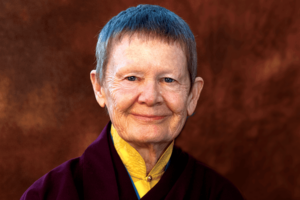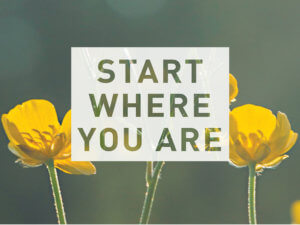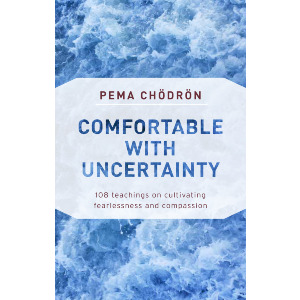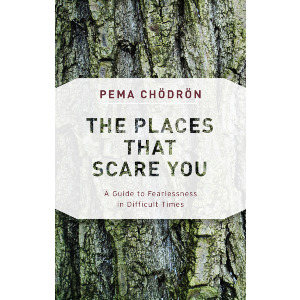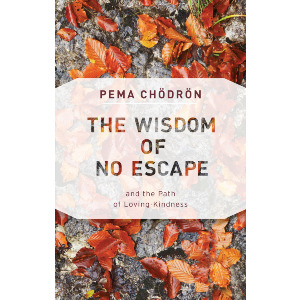How do we help? How do we create a saner world or a saner domestic situation or job situation, wherever we may be? How do we work with our actions and our speech and our minds in a way that opens up the space rather than closes it down? In other words, how do we create space for other people and ourselves to connect with our own wisdom? How do we create a space where we can find out how to become more a part of this world we are living in and less separate and isolated and afraid? How do we do that?
It all starts with loving-kindness for oneself, which in turn becomes loving-kindness for others. As the barriers come down around our own hearts, we are less afraid of other people. We are more able to hear what is being said, see what is in front of our eyes, and work in accord with what happens rather than struggle against it. The lojong teachings say that the way to help, the way to act compassionately, is to exchange oneself for other. When you can put yourself in someone else’s shoes, then you know what is needed, and what would speak to the heart.
I recently received a letter from a friend in which she dumped all over me and told me off. My first reaction was to be hurt and my second reaction was to get mad, and then I began to compose this letter in my mind, this very dharmic letter that I was going to write back to her using all the teachings and all the lojong logic to tell her off. Because of the style of our relationship, she would have been intimidated by a dharmic letter, but it wouldn’t have helped anything. It would have further forced us into these roles of being two separate people, each of us believing in our roles more and more seriously, that I was the one who knew it all and she was the poor student. But on that day when I had spent so much energy composing this letter, just by a turn of circumstance, something happened to me that caused me to feel tremendous loneliness. I felt sad and vulnerable. In that state of mind, I suddenly knew where my friend’s letter had come from—loneliness and feeling left out. It was her attempt to communicate.
Sometimes when you’re feeling miserable, you challenge people to see if they will still like you when you show them how ugly you can get. Because of how I myself was feeling I knew that what she needed was not for somebody to dump back on her. So I wrote a very different letter from what I had planned, an extremely honest one that said, “You know, you can dump on me all you like and put all of your stuff out there, but I’m not going to give up on you.” It wasn’t a wishy-washy letter that avoided the issue that there had been a confrontation and that I had been hurt by it. On the other hand, it wasn’t a letter in which I went to the other extreme and lashed out. For the first time, I felt I had experienced what it meant to exchange oneself for other. When you’ve been there you know what it feels like, and therefore you can give something that you know will open up the space and cause things to keep flowing. You can give something that will help someone else connect with their own insight and courage and gentleness, rather than further polarize the situation.
“Drive all blames into one” is a pivotal slogan because usually driving blames into other comes from the fact that we’ve been hurt and therefore want to hurt back. It’s that kind of logic. Therefore the exchange—putting ourselves in someone else’s shoes—doesn’t come from theory, in which you try to imagine what someone else is feeling. It comes from becoming so familiar and so openhearted and so honest about who you are and what you do that you begin to understand humanness altogether and you can speak appropriately to the situation.
When you’ve been there you know what it feels like, and therefore you can give something that you know will open up the space and cause things to keep flowing.
The basic ground of compassionate action is the importance of working with rather than struggling against, and what I mean by that is working with your own unwanted, unacceptable stuff, so that when the unacceptable and unwanted appears out there, you relate to it based on having worked with loving-kindness for yourself. Then there is no condescension. This nondualistic approach is true to the heart because it’s based on our kinship with each other. We know what to say, because we have experienced closing down, shutting off, being angry, hurt, rebellious, and so forth, and have made a relationship with those things in ourselves.
This is not about problem resolution. This is a more open-ended and courageous approach. It has to do with not knowing what will happen. It has nothing to do with wanting to get ground under your feet. It’s about keeping your heart and your mind open to whatever arises, without hope of fruition. Problem solving is based first on thinking there is a problem and second on thinking there is a solution. The concepts of problem and solution can keep us stuck in thinking that there is an enemy and a saint or a right way and a wrong way. The approach we’re suggesting is more groundless than that.
A key slogan is “Change your attitude, but remain natural” or “Change your attitude and relax as it is.”
In order to have compassionate relationships, compassionate communication, and compassionate social action, there has to be a fundamental change of attitude. The notion “I am the helper and you are the one who needs help” might work in a temporary way, but fundamentally nothing changes, because there’s still one who has it and one who doesn’t. That dualistic notion is not really speaking to the heart.
As expressed in the lojong teachings, that fundamental change of attitude is to breathe the undesirable in and breathe the desirable out. In contrast, the attitude that is epidemic on the planet is that if it’s unpleasant we push it away and if it’s pleasant we hold tight and grasp it.
This change in attitude doesn’t happen overnight; it happens gradually, at our own speed. If we have the aspiration to stop resisting those parts of ourselves that we find unacceptable and instead begin to breathe them in, this gives us much more space. We come to know every part of ourselves, with no more monsters in the closet, no more demons in the cave. We have some sense of turning on the lights and looking at ourselves honestly and with great compassion.
We could begin to get the hang of changing our attitude on an everyday level: when things are delightful and wonderful we give our pleasure away on the outbreath, sharing it with others. That also allows for enormous space—not just for us, but for everyone. When we do this, all of our inner obstacles that keep us from connecting with our inherent freshness and openness begin to dissolve. This is the fundamental change of attitude—this working with pain and pleasure in a revolutionary and courageous way.
When we work with pain by leaning into it and with pleasure by giving it away, it doesn’t mean that we “grin and bear it.” This approach is a lot more playful than that—like dancing with it. We realize that this separateness that we feel is a funny kind of mistake. We see that things were not dualistic from the start; we can wake up to that realization. The basis of any real kind of compassionate action is the insight that the others who seem to be out there are some kind of mirror image of ourselves. By making friends with yourself, you make friends with others. By hurting others, you hurt yourself.
Another slogan says, “Always abide by the three basic principles.” The first basic principle is always to abide by any vows you have taken—the refuge vows that you take to become a Buddhist and the bodhisattva vows taken later as an expression of your wish to benefit others. The second principle is to refrain from showing off, or from outrageous conduct. The third is always to cultivate patience. So these are the three basic principles: keeping the vows you have taken, refraining from outrageous conduct, and cultivating patience.
The basis of any real kind of compassionate action is the insight that the others who seem to be out there are some kind of mirror image of ourselves.
Keeping the Vows You Have Taken
The first principle, to keep the vows you have taken, speaks specifically to those of us who have taken the refuge vows and bodhisattva vows, but it may be helpful for everyone to hear a little bit about these vows. The refuge vow is basically about making a commitment to become a refugee, which in essence means that rather than always trying to get security, you begin to develop an attitude of wanting to step into uncharted territory. It’s a vow that you take because you feel that the way to health and becoming a complete human being is to no longer hold so tightly to yourself. You long to go beyond that situation. You are no longer afraid of yourself. You can become a refugee because when you aren’t afraid of yourself, you don’t feel that you need a protected place to hide in.
The image of the bodhisattva vow could be, “Not afraid of others.” When you take the bodhisattva vow you open the windows and doors and invite all sentient beings as your guests. Having understood the futility and pain of always holding on to yourself, you want to take the next step and begin to work with others.
You might think that you are working with others because you are much more sane than they are and you want to spread that sanity. But a more profound insight is that you realize that the only way to go further is to open those doors and windows and not protect yourself any more but work with whatever arrives. That’s the only way to wake up further. The motivation for making friends with yourself becomes wanting to help others; these two work together. You know you can’t help others if you’re not making friends with yourself.
Refraining from Outrageous Conduct
The second basic principle is to refrain from outrageous conduct. If you have this ideal of yourself as a hero or helper or doctor and everybody else as the victim, the patient, the deprived, the underdog, you are continuing to create the notion of separateness.
Someone might end up getting more food or better housing, and that’s a big help; those things are necessary. But the fundamental problem of isolation, hatred, and aggression is not addressed. Or perhaps you get flamboyant in your helper role. You often see this with political action. People make a big display, and suddenly the whole thing doesn’t have to do with helping anyone at all but with building themselves up.
In the seventies there was a famous photograph in which the National Guard were all lined up with their guns at an antiwar rally. A young woman had walked up and put a flower in the end of one of the guns, and the photo appeared in all the newspapers. I read a report in which the soldier who had been holding that gun—who later became a strong peace activist—said that he had never before experienced anything as aggressive as that young woman coming with her flower and smiling at everybody and making this big display. Most of those young guys in the National Guard were already questioning how they got on that particular side of the fence anyway. And then along came this flower child. She never looked in his eyes; she never had any sense of him as a person. It was all for display, and it hurt. So that’s part of the point of this slogan. You have to question what’s behind your action, especially if it is making a big splash.
Cultivating Patience
The last of the three basic principles is to cultivate patience, which is the same as cultivating nonaggression. Patience and nonaggression are basically encouragement to wait. Sometimes I think of tonglen that way. You are in a situation in which you would normally just yell back or throw something or think of the person you are with in the same old stuck way. Instead it occurs to you to begin to do the exchange for other. This whole solid sense of self and other begins to get addressed when you cultivate patience. You learn to pause, learn to wait, learn to listen, and learn to look, allowing yourself and others some space—just slowing down the camera instead of speeding it up.
It’s a little bit like the old advice to count to ten before you say something; it makes you pause. If you become afraid or angry, there is a natural kind of adrenaline principle, when the camera actually starts to speed up. The speeding up itself can bring you back to the present. You can use it as a reminder just to slow down and listen and look and wait and develop patience.
“Abandon poisonous food” and “Don’t make gods into demons” are warnings that only you know whether what you are doing is good practice (“gods” or “good food”). Anything could be used to build yourself up and smooth things over and calm things down or to keep everything under control. Good food becomes poisonous food and gods become demons when you use them to keep yourself in that room with the doors and windows closed.
Another slogan that concerns compassionate action is “Work with the greatest defilements first.” Developing loving-kindness for yourself is the basis for compassionate communication and relationship. The time is now, not later. The greatest defilement is what you consider to be the greatest obstacle. This slogan is suggesting that you start where you feel most stuck. Making friends with that will begin to automatically take care of the smaller obstacles.
Because the larger obstacles like rage or jealousy or terror are so dramatic, their vividness itself may be a reminder to work with the practice of tonglen. We may so take for granted the multitude of minor daily irritations that we don’t even think of them as something to work with. To some degree they are the hardest obstacles to work with because they don’t reveal themselves. The only way you know that these are arising is that you feel righteous indignation. Let righteous indignation be your guide that someone is holding on to themselves, and that someone is probably you.
If you begin to work with the greater defilements, or the major stuck places, these little ones tend to become more obvious to you as well. Whereas if you try to work with all of these little ones, they are like your hands and your nose; you don’t even think of them as anything but you, and there is no sense of them as obstacle. You just buy them every time they happen.
Our greatest obstacles are also our greatest wisdom. In all the unwanted stuff there is something sharp and penetrating; there’s great wisdom there. Suppose anger or rage is what we consider our greatest obstacle, or maybe it’s addiction and craving. This breeds all kinds of conflict and tension and stress, but at the same time it has a penetrating quality that cuts through all of the confusion and delusion. It’s both things at once.
When you realize that your greatest defilement is facing you and there seems no way to get out of it because it’s so big, the instruction is, let go of the story line, let go of the conversation, and own your feeling completely. Let the words go and return to the essential quality of the underlying stuff. That’s the notion of the inbreath, the notion of making friends with ourselves at a profound level. In the process we are making friends with all sentient beings, because that is what life is made of. Working with the greater defilements first is saying that now is the time, and also that our greatest obstacles are our greatest wealth. From the point of view of wanting to stay cozy and separate in your room, this work is extremely threatening. Part of the path of compassionate action is to begin to explore that notion of the inbreath and test it, to see if it rings true for you.
Related Books
$19.95 - Paperback
$18.95 - Paperback
$17.95 - Paperback
$16.95 - Paperback
$16.95 - Paperback
